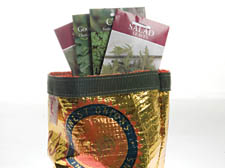|
|
 |
| |
Seed of an idea for the Olympics
Tom Moggach spells out the secret growing plants from scratch
A FEW weeks ago, I cycled down to Somers Town for a meeting for Capital Growth, the new campaign to create 2,012 food growing spaces in the run-up to the 2012 Olympics.
It’s a thrilling idea, backed by mayor Boris Johnson. The plan is to find patches of disused land – from railway embankments to rooftops – then negotiate with the owners to open them up to community groups who are itching to grow their own.
The first wave of sites, including a plot behind the School of Oriental and African Studies in King’s Cross, has just got the green light. Other ideas in the pipeline include floating allotments on canal barges across the capital.
At the meeting, we swapped tips and shared expertise, from where to buy five tons of topsoil to tricks for tracking down landowners.
Global Generation, a charity based in Kentish Town, were also there. They’ve created rooftop allotments on office buildings, including the company that designed the Olympic logo.
It’s early days for Capital Growth. To get involved, sign up on their website (capitalgrowth.org). But this first get together was all about sowing seeds for success, the topic of this week’s column:
Buying seed
It’s a recession all right, but the seed companies are laughing. They’re doing a roaring trade these days, especially in vegetable seed. Shop around online for the widest selection. Check out Suffolk Herbs (suffolkherbs.com), Real Seeds (realseeds.co.uk) and Marshalls (marshalls-seeds.co.uk).
Heritage varieties
Long-forgotten varieties are now achingly trendy. Just like the food snobs, some growers get a kick from the rare stuff – kale from a windswept Scottish island, chillies from a remote oasis in Morocco.
On a serious note, it’s a fact that we’ve lost more than 90 per cent of our vegetable varieties in the past century.
So do try some heritage seeds to help to promote biodiversity and preserve the gene pool. Sign up as a member of Heritage Seed Library (garden organic.org.uk/hsl). But cover yourself with a few foolproof varieties from the garden centre.
Sowing seed
Seed comes in all shapes and sizes, from minute wild rocket seed to chunky broad beans, and there’s no hard and fast rules.
Read the packet if in doubt: root crops such as carrots must be sown direct into the soil; others don’t mind being moved. Keep unused seeds in an airtight container in your fridge.
Stagger your sowings
It’s best to sow little and often, especially with crops such as lettuces, carrots or radishes. Otherwise you end up with glut all at once. Sow every two weeks for a constant supply.
Watering
Water from below with seed trays, module trays or pots. Let them soak in a tray or the sink until the soil takes on a darker sheen. That way you won’t disturb the delicate roots of young plants.
Keep an eye out
Check every morning. As soon as seed germinates, they need light. Whack them on a windowsill, rotating every day to make sure they do not grow wonky as they strain towards the light.
Harden them up
Plants grown indoors need toughening up before they go outside. Brush seedlings back and forth with your hand or brush to mimic the motion of the wind. Harden them off for a week or so by slowly increasing the time they spend outdoors.
|
 |
|
|
 |

|
|
 |
|









